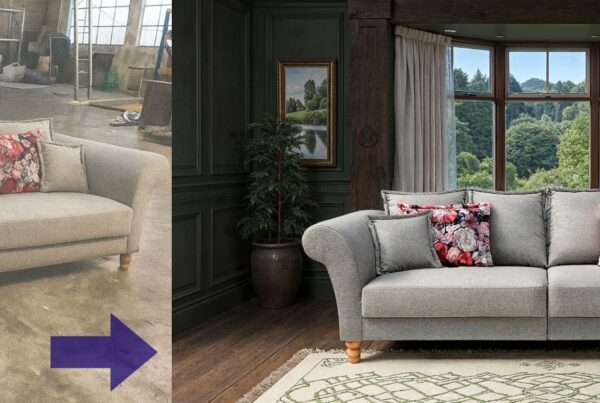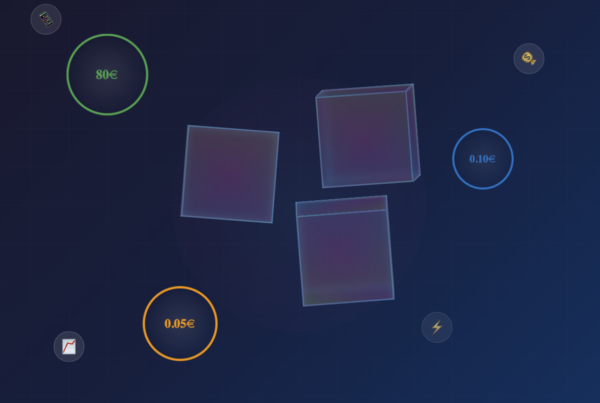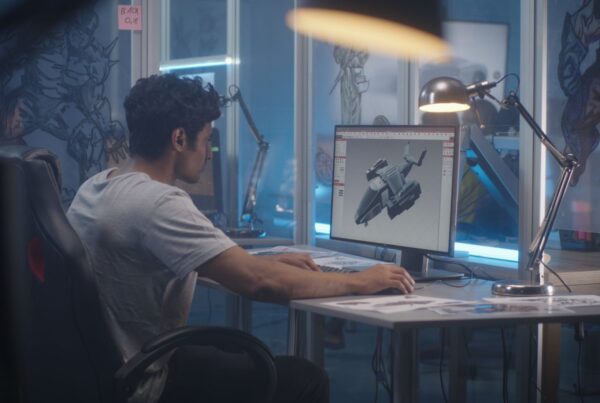What the trade revolution is all about
Spatial computing was launched as a marketing term by Apple with the product launch of the Apple Vision Pro. Just like the Metaverse from Meta. Spatial computing stands for the sustainable optimization of the shopping experience. It is an innovation that blurs our physical reality with virtual reality. This creates an augmented reality (AR).
Spatial Computing and Augmented Reality: So far Vs. Today
So far
Today, it is still possible for companies to transform their 2D images into 3D models with the help of suitable software and services. At Mazing, for example, 3D modeling works in such a way that realistic 3D models are created with just 2-3 product images.
The 3D models can then be used in various forms and integrated into the store. It is possible to provide a 3D viewer in the store to give customers the opportunity to view the product from any desired perspective. The 3D configurator can also be used to change and adapt the size, color or texture of the product, for example.
With the right web AR software, it is also possible to place products in your own home at the click of a button and experience augmented reality like never before.
The multiplacement feature makes it possible to place several products in the room and thus furnish the entire living area, for example. This is usually augmented reality for furniture manufacturers.
Last but not least, the virtual try-on function allows you to virtually try on shoes or glasses before you buy them.
Today
Spatial computing and the innovation of Apple Vision Pro take 3D experiences and web augmented reality to a new level. You can now view the products not only through a cell phone camera in the room, but literally through your own eyes. When you put on the Vision Pro, you can walk around the room and walk around the virtually placed product. You can view it from any perspective, move it around the room as you want it to be and assess whether the size or color fits into the room. The only thing missing from this experience is the satisfaction of kinaesthetic perception. You can’t feel the product, but you still have the feeling that it really is in your own room.
Spatial computing is a retail revolution for online stores. Vision Pro paves new ways to expand the touchpoints in the customer journey and thus sustainably optimize the entire customer experience.
Where spatial computing is used
- Furniture, furnishings, art and interior design
With the help of spatial computing, you can try out furniture, furnish rooms and shop without worrying because you know for sure that the products will fit. Products range from hot tubs, garden huts and barbecues to beds, chests of drawers and lamps. You can try out and view works of art on your own wall before ordering them. Interior design is also fundamentally changed and optimized. - Try-On:
Spatial computing also optimizes the virtual try-on function. Shoes can easily be tried on using Web AR and viewed through the Vision Pro. You can even place bicycles, motorcycles and cars so that you can imagine the size realistically without having to take a tour beforehand. - Household:
The Vision Pro offers the possibility of vacuuming with a Web AR function to recognize exactly which area has already been vacuumed and which is still missing. This makes cleaning easier and saves a lot of time in everyday life. - Industry:
Spatial computing enables industrial companies to optimize the interaction between machines and people. The activity of machines can be continuously analyzed and all dynamic processes can be better assessed.
Here is an example for an even better visualization: If you click on the “View in Room” button, you can place the product in your current room.
Now imagine that the table is not only visible through the small screen on your cell phone, but through your own eyes. This is exactly what Apple is offering with Vision Pro and what Spatial Computing is supposed to stand for: displaying products as realistically as possible.
How spatial computing contributes to the sustainable optimization of eCommerce
- Personalization and individuality:
Customers are attaching more and more importance to receiving a personalized shopping experience. They need a reason why they should not shop with the competition. A clear exclusivity should be offered and this can be provided through the use of spatial computing. - Increase customer satisfaction:
By integrating spatial computing into your own online store, you offer customers additional benefits, increase satisfaction and strengthen customer loyalty. - Lower return rates:
Spatial computing reduces returns by up to 70%. This results in lower transportation costs, contributes to lower emissions and protects the environment. - Higher sales figures and better conersion rates:
The implementation of Spatial Computing contributes to more sales as it gives customers a sense of security. This results in higher sales figures for the company.
Summary
Spatial computing is an upgrade in eCommerce and for all 3D displays and web AR solutions. It is the latest technological innovation in the field of augmented reality and expands the range of ways in which online stores can secure a unique selling point. Vision Pro can be used for different product groups to display them more realistically than ever before. For online stores, there are many different positive aspects to integrating spatial computing. Mazing’s Web AR software is suitable for implementation in both the online store and the Apple Vision Pro. Let our team of experts advise you now and find out how you can use spatial computing as an advantage for your company.





